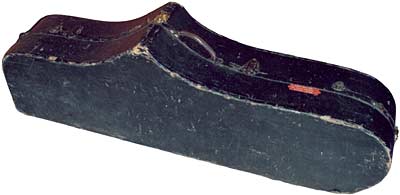|
Original
Bass Case
|
 |
I suffer from a long-standing love affair with vintage saxes. Sadly, these saxophones come in vintage cases, many of which are starting to turn to sawdust (like the one pictured above).
The leather strap that holds the bell up disintegrated the day before a long road trip. I managed to attach an old belt but it just barely survived the trip before the wood the belt was attached to gave out. It became clear that simple repairs were no longer an option--I needed a new case if I was going to take this horn out of the house.
For the smaller, common horns (soprano, alto, tenor, & bari), this is not really a problem, since there are many fine after-market cases available. But when the customer is a bass sax owner, it becomes a bit trickier, since there are very few companies that make bass cases to fit an 80-year-old horn.
The story that follows, tells how I came to own my custom- built case.
When I decided to replace the case for my bass saxophone, I first did some checking into the availability of new cases. I found out that my choices were very limited. Basically, I could get a generic bass sax case, made by Allied, for about $450 US. I really wanted something that was a bit more specific to the horn, so I contacted Walt Johnson. A case for my Buescher would be $850 US.
On the Sax On The Web discussion forum, a number of bass sax players had started to exchange ideas. Steve Weinert, from Wisconsin, was in the process of convincing General Woodworking (which makes OEM instrument cases) to design and build bass sax replacement cases. I started figuring what it would cost, given the exchange rate, taxes, and shipping, and I began to think that there had to be a better way to go about this.
A friend suggested that I get a boat builder to build a custom case for me. There is a community college in nearby Saint Andrews that offers a boat-building program. She suggested that I find a graduate from that program to help me.
|
Through another friend, I found a skilled craftsman, Bruce Campbell. Bruce is based in Saint Andrews, New Brunswick. Besides being a boat builder,
|
 |
Bruce also plays French horn, so he is familiar with the delicacy of musical instruments. I gave Bruce a call in January 2002. He came to visit me a few weeks later.
After spending some time talking to me and looking at the existing case (that was disintegrating), we decided to proceed in the design of a new case, rather than trying to rebuild the old one.
Bruce took some preliminary measurements, and said that he was busy until at least the middle of February, but would start to think about it and begin to come up with a plan.
The next time he came to visit, we began to think about things: What shape should this case be? How would I want it finished? What kind of hinges and case closures did I want? Did I want wheels? What kind of storage did I want inside the case? Etc. Etc. For an indecisive person like myself, this was truly torturous. I agonized over ever detail, trying to make the best choices possible.
We decided on a 5-sided box, rather than a rectangle. With this in mind, Bruce went about making the final measurements.
The next time I saw Bruce, he came to visit with a fiberglassed wooden box, that resembled a coffin in size and shape. We tried to lay the sax in the box. Success! His measurements had been extremely accurate. The sax fit in perfectly, with enough room for padding on all sides. We decided to use rigid foam to build the sax support structures inside the case. The foam water-noodles that children use in a pool are what we decided upon. This material is firm enough to support the weight of the horn, but soft enough to not cause any damage. It also has a memory, so the weight and angles of the sax would ensure a custom fit.
More...
Back to the top of the page.